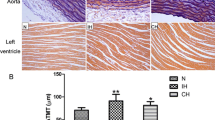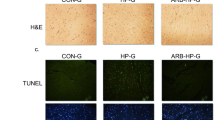Abstract
Background and objective
Obstructive sleep apnea (OSA) and heart failure (HF) are common coexisting diseases. Intermittent hypoxia (IH), caused by repeated apnea/hypopnea events, accompanied by increased systemic inflammation, might contribute to the promotion of HF.
Methods
To assess the hypothesis, rats were exposed to IH or normal air condition 4 weeks on the basis of normal heart function or pre-existing HF, which was induced by pressure overload caused by abdominal aortic constriction surgery performed 12 weeks earlier. Echocardiography was performed before and after IH exposure to evaluate left ventricular (LV) function. Serum concentrations of pro-inflammatory cytokines TNF-α and IL-6 were detected by enzyme-linked immunosorbent assay. Flow cytometric analysis was used to determine the apoptotic rate of polymorphonuclear neutrophils (PMNs).
Results
The echocardiographic study showed a significant decrease in LV fractional shortening (FS) and ejection fraction (EF) as well as an increase in the LV relative wall thickness (RWT) index in HF rats, which was aggravated by further exposure to IH compared with single-handed HF-only and sham-IH and sham-control groups. A reduced PMN apoptotic rate was observed in HF-IH rats compared with HF-only, sham-IH, and sham-control rats. Serum concentrations of TNF-α and IL-6 were also increased in HF-IH rats, accompanied by delayed PMN apoptosis, indicating significant systemic inflammation induced by IH.
Conclusion
The results of this study demonstrated that IH aggravates LV remodeling and heart dysfunction in rats with pre-existing HF. Delayed neutrophil apoptosis, which was revealed in HF rats following exposure to IH, contributed to the exacerbation of myocardial damage and progression of heart dysfunction.



Similar content being viewed by others
References
Marin JM, Carrizo SJ, Vicente E et al (2005) Long-term cardiovascular outcomes in men with obstructive sleep apnoea-hypopnoea with or without treatment with continuous positive airway pressure: an observational study. Lancet 365(9464):1046–1053
Shahar E, Whitney CW, Redline S et al (2001) Sleep-disordered breathing and cardiovascular disease: cross-sectional results of the Sleep Heart Health Study. Am J Respir Crit Care Med 163(1):19–25
Young T, Finn L, Peppard PE et al (2008) Sleep disordered breathing and mortality: eighteen-year follow-up of the Wisconsin sleep cohort. Sleep 31(8):1071–1078
Yumino D, Wang H, Floras JS et al (2009) Prevalence and physiological predictors of sleep apnea in patients with heart failure and systolic dysfunction. J Card Fail 15(4):279–285
Ferrier K, Campbell A, Yee B et al (2005) Sleep-disordered breathing occurs frequently in stable outpatients with congestive heart failure. Chest 128(4):2116–2122
Vazir A, Hastings PC, Dayer M et al (2007) A high prevalence of sleep disordered breathing in men with mild symptomatic chronic heart failure due to left ventricular systolic dysfunction. Eur J Heart Fail 9(3):243–250
Garlichs CD, Eskafi S, Cicha I et al (2004) Delay of neutrophil apoptosis in acute coronary syndromes. J Leukoc Biol 75(5):828–835
Biasucci LM, Liuzzo G, Giubilato S et al (2009) Delayed neutrophil apoptosis in patients with unstable angina: relation to C-reactive protein and recurrence of instability. Eur Heart J 30(18):2220–2225
Dyugovskaya L, Polyakov A, Lavie P et al (2008) Delayed neutrophil apoptosis in patients with sleep apnea. Am J Respir Crit Care Med 177(5):544–554
Gomes AC, Falcao-Pires I, Pires AL et al (2013) Rodent models of heart failure: an updated review. Heart Fail Rev 18(2):219–249
Xu XB, Pang JJ, Cao JM et al (2005) GH-releasing peptides improve cardiac dysfunction and cachexia and suppress stress-related hormones and cardiomyocyte apoptosis in rats with heart failure. Am J Physiol Heart Circ Physiol 289(4):H1643–H1651
Chung ES, Perlini S, Aurigemma GP et al (1998) Effects of chronic adenosine uptake blockade on adrenergic responsiveness and left ventricular chamber function in pressure overload hypertrophy in the rat. J Hypertens 16(12 Pt 1):1813–1822
Feng J, Chen BY, Cui LY et al (2009) Inflammation status of rabbit carotid artery model endothelium during intermittent hypoxia exposure and its relationship with leptin. Sleep Breath 13(3):277–283
Feng J, Wang QS, Chiang A et al (2010) The effects of sleep hypoxia on coagulant factors and hepatic inflammation in emphysematous rats. PLoS ONE 5(10):e13201
Teichholz LE, Kreulen T, Herman MV et al (1976) Problems in echocardiographic volume determinations: echocardiographic-angiographic correlations in the presence of absence of asynergy. Am J Cardiol 37(1):7–11
Tidholm A, Westling AB, Hoglund K et al (2010) Comparisons of 3-, 2-dimensional, and M-mode echocardiographical methods for estimation of left chamber volumes in dogs with and without acquired heart disease. J Vet Intern Med 24(6):1414–1420
Lang RM, Bierig M, Devereux RB et al (2006) Recommendations for chamber quantification. Eur J Echocardiogr 7(2):79–108
da Silva MG, Mattos E, Camacho-Pereira J et al (2012) Cardiac systolic dysfunction in doxorubicin-challenged rats is associated with upregulation of MuRF2 and MuRF3 E3 ligases. Exp Clin Cardiol 17(3):101–109
Krumholz HM, Larson M, Levy D (1995) Prognosis of left ventricular geometric patterns in the Framingham Heart Study. J Am Coll Cardiol 25(4):879–884
Strober, W. (2001) Trypan blue exclusion test of cell viability. Curr Protoc Immunol; Appendix 3: Appendix 3B.
Vermes I, Haanen C, Steffens-Nakken H et al (1995) A novel assay for apoptosis. Flow cytometric detection of phosphatidylserine expression on early apoptotic cells using fluorescein labelled Annexin V. J Immunol Methods 184(1):39–51
El Solh AA, Akinnusi ME, Baddoura FH et al (2007) Endothelial cell apoptosis in obstructive sleep apnea: a link to endothelial dysfunction. Am J Respir Crit Care Med 175(11):1186–1191
Li S, Qian XH, Zhou W et al (2011) Time-dependent inflammatory factor production and NFkappaB activation in a rodent model of intermittent hypoxia. Swiss Med Wkly 141:w13309
Egea CJ, Aizpuru F, Pinto JA et al (2008) Cardiac function after CPAP therapy in patients with chronic heart failure and sleep apnea: a multicenter study. Sleep Med 9(6):660–666
Krieger J, Grucker D, Sforza E et al (1991) Left ventricular ejection fraction in obstructive sleep apnea. Effects of long-term treatment with nasal continuous positive airway pressure. Chest 100(4):917–921
Cioffi G, Russo TE, Stefenelli C et al (2010) Severe obstructive sleep apnea elicits concentric left ventricular geometry. J Hypertens 28(5):1074–1082
Jimenez MF, Watson RW, Parodo J et al (1997) Dysregulated expression of neutrophil apoptosis in the systemic inflammatory response syndrome. Arch Surg 132(12):1263–1269, discussion 9–70
Biffl WL, Moore EE, Moore FA et al (1996) Interleukin-6 delays neutrophil apoptosis. Arch Surg 131(1):24–29, discussion 9–30
Matsuda T, Saito H, Fukatsu K et al (2001) Cytokine-modulated inhibition of neutrophil apoptosis at local site augments exudative neutrophil functions and reflects inflammatory response after surgery. Surgery 129(1):76–85
Francois S, El Benna J, Dang PM et al (2005) Inhibition of neutrophil apoptosis by TLR agonists in whole blood: involvement of the phosphoinositide 3-kinase/Akt and NF-kappaB signaling pathways, leading to increased levels of Mcl-1, A1, and phosphorylated Bad. J Immunol 174(6):3633–3642
Beg AA, Baltimore D (1996) An essential role for NF-kappaB in preventing TNF-alpha-induced cell death. Science 274(5288):782–784
Walmsley SR, Print C, Farahi N et al (2005) Hypoxia-induced neutrophil survival is mediated by HIF-1alpha-dependent NF-kappaB activity. J Exp Med 201(1):105–115
Choi M, Rolle S, Wellner M et al (2003) Inhibition of NF-kappaB by a TAT-NEMO-binding domain peptide accelerates constitutive apoptosis and abrogates LPS-delayed neutrophil apoptosis. Blood 102(6):2259–2267
Acknowledgments
This study was supported by the grants from National Natural Science Foundation of China (No. 30800507, 30770934, 30900656)
Conflict of interest
None of the authors has a financial relationship with a commercial entity that has an interest in the subject of this manuscript.
Author information
Authors and Affiliations
Corresponding authors
Additional information
Shuo Li and Jing Feng contributed equally to this work.
Rights and permissions
About this article
Cite this article
Li, S., Feng, J., Wei, S. et al. Delayed neutrophil apoptosis mediates intermittent hypoxia-induced progressive heart failure in pressure-overloaded rats. Sleep Breath 20, 95–102 (2016). https://doi.org/10.1007/s11325-015-1190-2
Received:
Revised:
Accepted:
Published:
Issue Date:
DOI: https://doi.org/10.1007/s11325-015-1190-2




